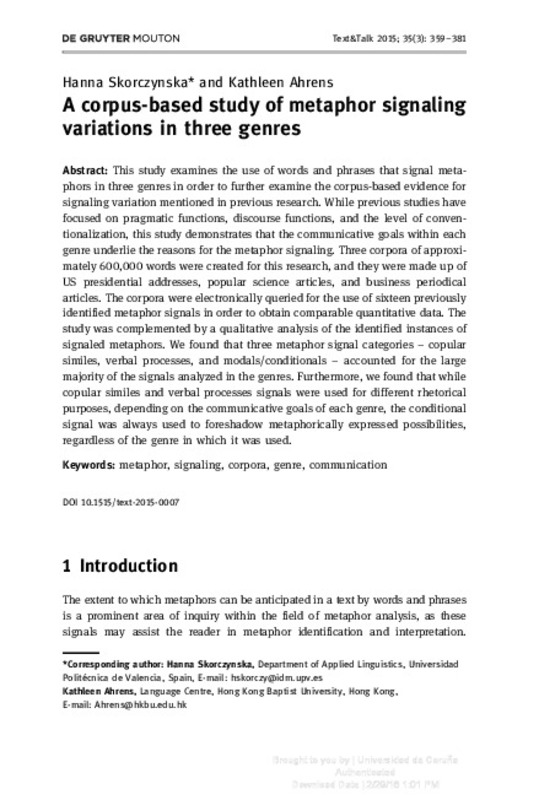JavaScript is disabled for your browser. Some features of this site may not work without it.
Buscar en RiuNet
Listar
Mi cuenta
Estadísticas
Ayuda RiuNet
Admin. UPV
A corpus-based analysis of metaphor signaling in three genres
Mostrar el registro sencillo del ítem
Ficheros en el ítem
| dc.contributor.author | Skorczynska Sznajder, Hanna Teresa
|
es_ES |
| dc.contributor.author | Ahrens, Kathleen
|
es_ES |
| dc.date.accessioned | 2016-04-25T13:08:04Z | |
| dc.date.available | 2016-04-25T13:08:04Z | |
| dc.date.issued | 2015 | |
| dc.identifier.issn | 1860-7330 | |
| dc.identifier.uri | http://hdl.handle.net/10251/62888 | |
| dc.description.abstract | This study examines the use of words and phrases that signal metaphors in three genres in order to further examine the corpus-based evidence for signaling variation mentioned in previous research. While previous studies have focused on pragmatic functions, discourse functions, and the level of conventionalization, this study demonstrates that the communicative goals within each genre underlie the reasons for the metaphor signaling. Three corpora of approximately 600,000 words were created for this research, and they were made up of US presidential addresses, popular science articles, and business periodical articles. The corpora were electronically queried for the use of sixteen previously identified metaphor signals in order to obtain comparable quantitative data. The study was complemented by a qualitative analysis of the identified instances of signaled metaphors. We found that three metaphor signal categories copular similes, verbal processes, and modals/conditionals accounted for the large majority of the signals analyzed in the genres. Furthermore, we found that while copular similes and verbal processes signals were used for different rhetorical purposes, depending on the communicative goals of each genre, the conditional signal was always used to foreshadow metaphorically expressed possibilities, regardless of the genre in which it was used. | es_ES |
| dc.description.sponsorship | The first author would like to thank Generalitat Valenciana (Spain) for the grant (BEST/2009/243) supporting this research. The second author would like to thank Hong Kong Baptist University for a Faculty Research Grant which supported a portion of this research (FRG/08-09/II-27). Special thanks also go to the second author's project assistant, Ivy Chan Wing Shan, for her assistance with the data analysis in this paper. We are grateful for comments and suggestions received from two anonymous reviewers. All errors are our own responsibility. | en_EN |
| dc.language | Inglés | es_ES |
| dc.publisher | De Gruyter | es_ES |
| dc.relation.ispartof | Text and Talk | es_ES |
| dc.rights | Reserva de todos los derechos | es_ES |
| dc.subject | Metaphor | es_ES |
| dc.subject | Signaling | es_ES |
| dc.subject | Corpora | es_ES |
| dc.subject | Genre | es_ES |
| dc.subject | Communication | es_ES |
| dc.subject.classification | FILOLOGIA INGLESA | es_ES |
| dc.title | A corpus-based analysis of metaphor signaling in three genres | es_ES |
| dc.type | Artículo | es_ES |
| dc.identifier.doi | 10.1515/text-2015-0007 | |
| dc.relation.projectID | info:eu-repo/grantAgreement/Generalitat Valenciana//BEST%2F2009%2F243/ES/BEST%2F2009%2F243/ | es_ES |
| dc.relation.projectID | info:eu-repo/grantAgreement/HKBU//FRG%2F08-09%2FII-27/ | es_ES |
| dc.rights.accessRights | Abierto | es_ES |
| dc.contributor.affiliation | Universitat Politècnica de València. Departamento de Lingüística Aplicada - Departament de Lingüística Aplicada | es_ES |
| dc.description.bibliographicCitation | Skorczynska Sznajder, HT.; Ahrens, K. (2015). A corpus-based analysis of metaphor signaling in three genres. Text and Talk. 35(3):359-381. https://doi.org/10.1515/text-2015-0007 | es_ES |
| dc.description.accrualMethod | S | es_ES |
| dc.relation.publisherversion | http://dx.doi.org/10.1515/text-2015-0007 | es_ES |
| dc.description.upvformatpinicio | 359 | es_ES |
| dc.description.upvformatpfin | 381 | es_ES |
| dc.type.version | info:eu-repo/semantics/publishedVersion | es_ES |
| dc.description.volume | 35 | es_ES |
| dc.description.issue | 3 | es_ES |
| dc.relation.senia | 289491 | es_ES |
| dc.identifier.eissn | 1860-7349 | |
| dc.contributor.funder | Generalitat Valenciana | es_ES |
| dc.contributor.funder | Hong Kong Baptist University | es_ES |








